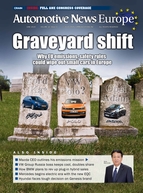Borrowing from the insurance industry, the system would capture events such as hard braking, sharp turns and sudden acceleration, so it could make apples-to-apples comparisons. Of course, crashes would be counted, too. But because self-driving vehicles will need to drive tens of millions of miles before statistically significant amounts of crash data exist, the hope is that other metrics can help.
"Waiting for AVs to crash, it's really hard to accumulate the data needed to calculate whether they crash at rates equal to or less than human drivers," Bin-Nun said. "So if we begin to think about noncrash events that tell us about the quality of driving, we'll have a way to benchmark. … It comes from the idea that we already understand in the context of human driving -- you can ride in [a] car with someone and you realize the person is not a great driver. There are behaviors to tell us that, and we intuitively understand."
Bin-Nun is vice president of autonomous vehicles and mobility innovation at Securing America's Future Energy, a nonpartisan Washington think tank that backs transportation policies that curb energy dependence on oil. A white paper by the organization in June 2018 found that automated vehicles could bring nearly $800 billion in economic benefits by 2050, "mostly from reducing the toll of vehicle crashes."
Bin-Nun, who said his work on the patent is separate from his role at Securing America's Future Energy, filed the application in November 2017 and then expanded on it last November. The patent and trademark office published the application in late May.
Other research on the subject helped shape the idea. In October, a Rand Corp. paper, "Measuring Automated Vehicle Safety: Forging A Framework," suggested that AVs would need leading indicators for measuring safety, not lagging ones such as crashes. It also proposed the idea of "roadmanship," a concept centered on measuring whether a vehicle "plays well with others" in traffic.

